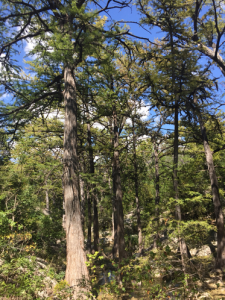 Bald Cypress trees, Taxodium distichum, are ornamental at Hamilton Pool. Their roots reach down into the creek waters and they stretch up to heights of about 120 feet. They are deciduous conifers that shed their leaves in early Fall; so early in fact it is the reason they were given the name “bald” cypress. Another interesting characteristic about this species and what they’re most known for is their “knees”. This is a term to describe the special type of roots they possess called pneumatophores, which means “air-bearing”. Because bald cypress trees are rooted into the water, the pneumatophores serve to transport air to drowned roots underground while also helping to stabilize the tree.
Bald Cypress trees, Taxodium distichum, are ornamental at Hamilton Pool. Their roots reach down into the creek waters and they stretch up to heights of about 120 feet. They are deciduous conifers that shed their leaves in early Fall; so early in fact it is the reason they were given the name “bald” cypress. Another interesting characteristic about this species and what they’re most known for is their “knees”. This is a term to describe the special type of roots they possess called pneumatophores, which means “air-bearing”. Because bald cypress trees are rooted into the water, the pneumatophores serve to transport air to drowned roots underground while also helping to stabilize the tree.
Bald Cypress trees are native throughout the southeastern United States. They are well-adapted to wet conditions along river banks and swamps, which has led them to be the state tree of Louisiana. Bald Cypresses are slow-growing, long-lived trees that frequently reach up to 600 years in age. They were valued for timber in the past, but their slow-growth characteristic has placed a higher priority on conserving them and their low numbers. It is also more difficult for loggers to harvest them within wetlands. These trees are very valuable in the wild. They soak up floodwaters, help prevent coastal erosion, trap pollutants and prevent them from spreading, and provide breeding grounds for many amphibians. Their high canopies are also popular for bird nests, most notably the bald eagle.
You can find my iNaturalist post here.
References
https://www.nwf.org/Wildlife/Wildlife-Library/Plants/Bald-Cypress.aspx